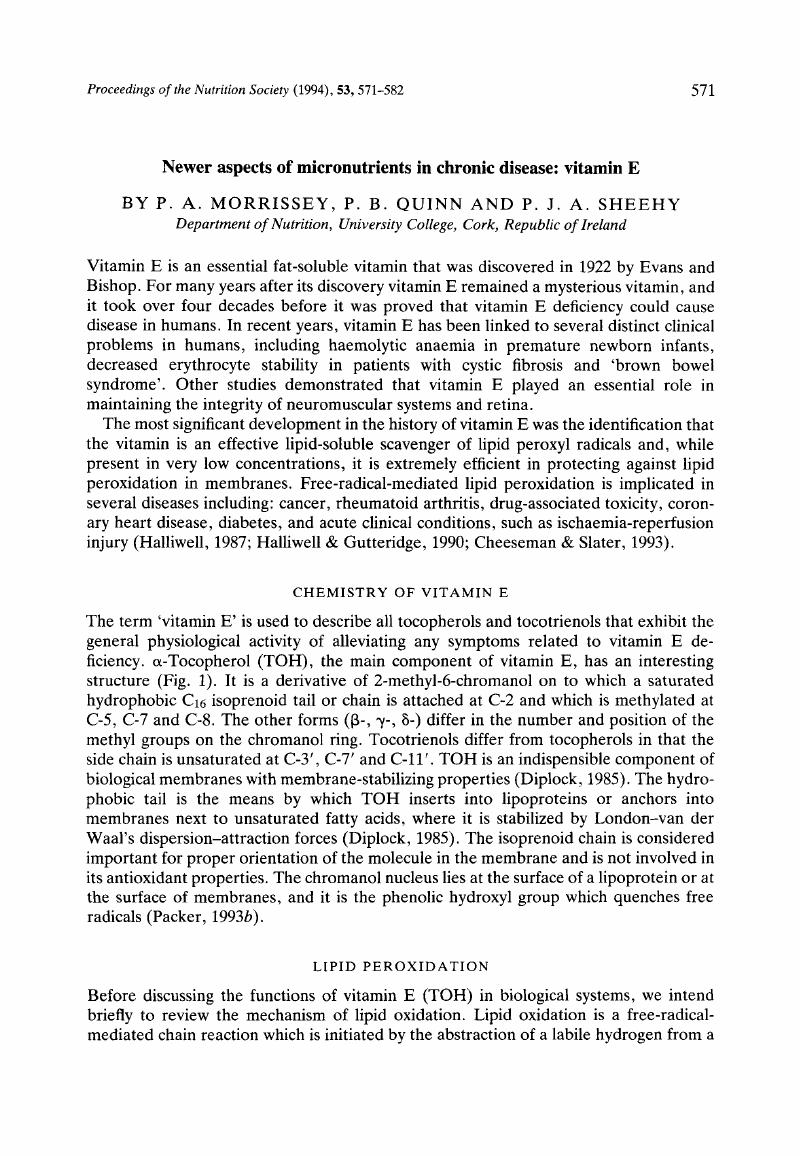Crossref Citations
This article has been cited by the following publications. This list is generated based on data provided by Crossref.
Wen, J.
Morrissey, P. A.
Buckley, D. J.
and
Sheehy, P. J. A.
1996.
Oxidative stability and α‐tocopherol retention in turkey burgers during refrigerated and frozen storage as influenced by dietary α‐tocopheryl acetate.
British Poultry Science,
Vol. 37,
Issue. 4,
p.
787.
Talwar, D
Ha, TK
Scott, HR
Cooney, J
Fell, GS
O’Reilly, DS
Lean, ME
and
McMillan, DC
1997.
Effect of inflammation on measures of antioxidant status in patients with non-small cell lung cancer.
The American Journal of Clinical Nutrition,
Vol. 66,
Issue. 5,
p.
1283.
Tang, S.Z
Kerry, J.P
Sheehan, D
Buckley, D.J
and
Morrissey, P.A
2000.
Dietary tea catechins and iron-induced lipid oxidation in chicken meat, liver and heart.
Meat Science,
Vol. 56,
Issue. 3,
p.
285.
Verma, S.P
and
Sahoo, J
2000.
Improvement in the quality of ground chevon during refrigerated storage by tocopherol acetate preblending.
Meat Science,
Vol. 56,
Issue. 4,
p.
403.
Morrissey, P.A.
and
Kerry, J.P.
2004.
Understanding and Measuring the Shelf-Life of Food.
p.
357.
Rizvi, Syed Ibrahim
and
Zaid, Mohammad Abu
2005.
Impairment of sodium pump and Na/H exchanger in erythrocytes from non-insulin dependent diabetes mellitus patients: effect of tea catechins.
Clinica Chimica Acta,
Vol. 354,
Issue. 1-2,
p.
59.
Lahučký, R.
Bahelka, I.
Novotná, K.
and
Vašíčková, K.
2005.
Effects of dietary vitamin E and vitamin C supplementation on the level of α-tocopherol and L-ascorbic acid in muscle and on the antioxidative status and meat quality of pigs.
Czech Journal of Animal Science,
Vol. 50,
Issue. 4,
p.
175.
Morrissey, P.A.
and
Hill, T.R.
2009.
Advanced Dairy Chemistry.
p.
527.
Jang, Sungjoon
and
Xu, Zhimin
2009.
Lipophilic and Hydrophilic Antioxidants and Their Antioxidant Activities in Purple Rice Bran.
Journal of Agricultural and Food Chemistry,
Vol. 57,
Issue. 3,
p.
858.
Rajani, J.
Karimi Torshizi, M.A.
and
Rahimi, Sh.
2011.
Control of ascites mortality and improved performance and meat shelf-life in broilers using feed adjuncts with presumed antioxidant activity.
Animal Feed Science and Technology,
Vol. 170,
Issue. 3-4,
p.
239.
Kumar, Navneet
Kant, Ruchi
Maurya, Pawan Kumar
and
Rizvi, Syed Ibrahim
2012.
Concentration Dependent Effect of (−)‐Epicatechin on Na+/K+‐ATPase and Ca2+‐ATPase Inhibition Induced by Free Radicals in Hypertensive Patients: Comparison with L‐ascorbic Acid.
Phytotherapy Research,
Vol. 26,
Issue. 11,
p.
1644.
Mapiye, C.
Dugan, M.E.R.
Juárez, M.
Basarab, J.A.
Baron, V.S.
Turner, T.
Yang, X.
Aldai, N.
and
Aalhus, J.L.
2012.
Influence of α-tocopherol supplementation on trans-18:1 and conjugated linoleic acid profiles in beef from steers fed a barley-based diet.
Animal,
Vol. 6,
Issue. 11,
p.
1888.
Borel, Patrick
Preveraud, Damien
and
Desmarchelier, Charles
2013.
Bioavailability of vitamin E in humans: an update.
Nutrition Reviews,
Vol. 71,
Issue. 6,
p.
319.
Al-Harthi, Mohammed A.
2014.
The Effect of Natural and Synthetic Antioxidants on Performance, Egg Quality and Blood Constituents of Laying Hens Grown Under High Ambient Temperature.
Italian Journal of Animal Science,
Vol. 13,
Issue. 2,
p.
3239.
Gabryszuk, M.
Kuźnicka, E.
Horbańczuk, K.
and
Oprządek, J.
2014.
Effects of Housing Systems and the Diet Supplements on the Slaughter Value and Concentration of Mineral Elements in the Loin Muscle of Lambs.
Asian-Australasian Journal of Animal Sciences,
Vol. 27,
Issue. 5,
p.
726.
Kalafová, Anna
Bulla, Jozef
Bučko, Ondrej
Emrichová, Jana
Zbyňovská, Katarína
Petruška, Peter
Schneidgenová, Monika
Chrastinová, Ľubica
Ondruška, Ľubomír
Jurčík, Rastislav
Mellen, Martin
and
Capcarová, Marcela
2015.
Quality of meat of rabbits after application of epicatechin and patulin.
Potravinarstvo Slovak Journal of Food Sciences,
Vol. 9,
Issue. 1,
p.
124.
Loganes, Claudia
Ballali, Simonetta
and
Minto, Clara
2016.
Main Properties of Canola Oil Components: A Descriptive Review of Current Knowledge.
The Open Agriculture Journal,
Vol. 10,
Issue. 1,
p.
69.
Schwarzova, Marianna
Fatrcova-Sramkova, Katarina
Tvrda, Eva
and
Kacaniova, Miroslava
2021.
Vitamin E in Health and Disease - Interactions, Diseases and Health Aspects.
Vol. 22,
Issue. ,
Aboelhadid, Shawky M.
Abdel-Baki, Abdel-Azeem S.
Hassan, Khaled M.
Arafa, Waleed M.
Abdel-Tawab, Heba
Al-Quraishy, Saleh
Hassan, Ahmed O.
Moawad, Usama K.
Ahmed, Osama
and
Kamel, Asmaa A.
2022.
Role of antioxidant activity of essential oils in their acaricidal activities against Rhipicephalus annulatus.
Experimental and Applied Acarology,
Vol. 88,
Issue. 2,
p.
209.



